
Available now!
Curly Like Me, the off-the-grid, do-it yourself owner's manual for tightly curly hair, is ready for ordering. Grab your copy today!
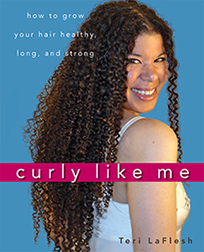
Every purchase made from
this site (through Amazon)
helps support it — and it
doesn't cost you anything
extra.
|
|
|
I believe having natural hair is a gift we give ourselves that just gets better and better over time. However, after using chemicals on it, or severely damaging it, our beautiful curls can be a challenge to grow back out again. This page will give you some tips for growing out your gorgeous curls if you aren't ready for the Big Chop just yet.
It's wonderful that you want to grow back your beautiful natural curls! Curls may seem like a challenge at first, but once we understand what they want, they are a joy to have. This page goes through what I did when I was growing out my relaxer.
Do I have to cut off all my hair?
I grew out my relaxer for about a year and a half before I cut off the chemical hair, so you don't have to cut it right away. The thing to keep in mind is that what counts is your new growth. Cutting off your chemical hair won't make your natural hair grow faster. It's more to make your life easier. Also, if you are doing things that damage your new growth in order to style the chemical hair, then the chemical hair should go. If the two textures cause you to yank a comb through your hair, then it's best to act in the interest of your new hair and cut the chemical hair. If you are able to treat your new hair gently, even with the chemical hair still there, and you aren't ready yet to cut it, then it's fine for it to stay.
The chemical hair is damaged, and if it's anything like mine was, it will continue to break off at the rate it's growing (making it look like it isn't growing). But that's fine, because you have beautiful, new strong hair coming in. So it's all about protecting the new growth. The bottom line is if you aren't ready to cut yet, and you are gentle with all your hair, then it's fine to leave the old hair. If you wanted, you could get the damaged hair trimmed about an inch every two months until it's gone, or you just don't want it on your head anymore.
After the Big Chop (and stopping any more damage occurring to my hair), it took me about ten years to grow my hair down to my tailbone. The two things that keep us from having long hair is that our hair is easily damaged, and the ways we have learned to care for our hair cause it lots of damage. Once we learn to care for our curls without damaging them any longer, our hair can finally grow to its maximum length. The trick is to learn to care for it without hurting it. I do have to tell you it isn't always easy to do, but getting rid of the relaxer is worth it no matter how you do it.
I strongly suggest taking some pictures along the way. That way when you have those gorgeous all natural curls, you can help and encourage others through this process by showing them the photos of your journey.
|

|
|
This is stunning Brianna (a huge thanks to Brianna for generously letting me demonstrate on her hair, and to Bob for taking all the great pictures). Her hair has been severely damaged by use of flat irons to the point most of her hair can't form curls anymore. Whether your damage is from flat irons, relaxers, or texturizers, if your new growth is very different from the older hair, the following tips are a way to match the two textures until you are ready to cut off the damaged hair.
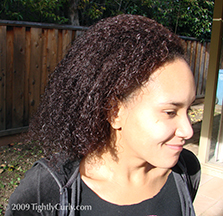
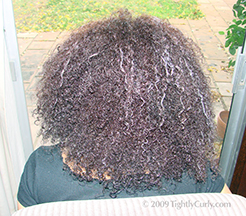
After washing her hair and coating it in a
combing conditioner, I take one to two inch sections of hair to comb and put in two-strand twists. You don't have to make neat parts. This is just a very simple set. I just divided the hair with my hands where it wanted to divide.
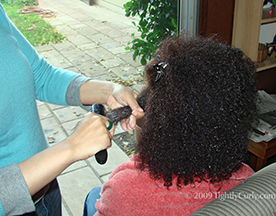
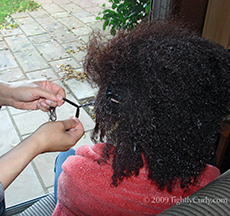
Two strand twists are done by dividing the section in half, and twisting one half around the other down to the ends.
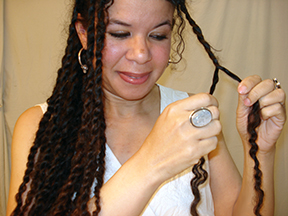
As I finish a twist, I clip it out of the way and move to the next spot.
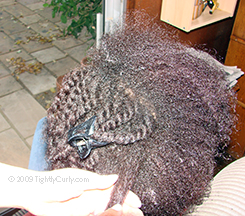
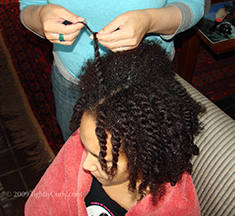
At the back of her neck, her hair is still curly, so I smooth those curls with conditioner instead of setting them in twists.
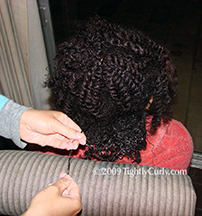
Brianna's twists are done. The best thing to do is to let them air dry. If you are pressed for time, you can use a diffuser on a very low setting. The twists are adorable enough that you could also wear this as a style. At night you can put your twists back in a bun or two to protect the ends. Or you can sleep in them as they are if they seem secure enough, or you need more time to let them dry.
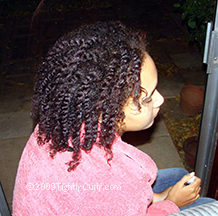
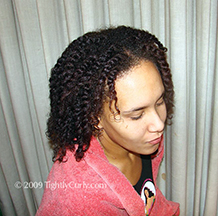
Here I am taking her twists out (make sure they are totally dry first). I've found the best way to take out twists is to hold the ends (they tend to snarl if you don't watch them). Then with the other hand, I pull open the twist, and let the ends twirl in the bottom hand. When the twist is nearly open, I twirl it the rest of the way open in my bottom hand.
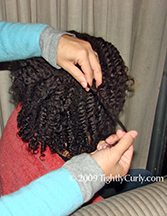
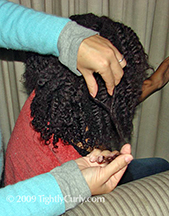
This is what lovely Brianna looked like with all her twists taken out. Her hair has much more definition and style than it did before. She could do this once a week or so until she's ready to cut off the damaged hair. At night, she could just put it back in a bun or two, or a couple braids. So long as she doesn't get it wet, or comb or brush it, this set should last all week.
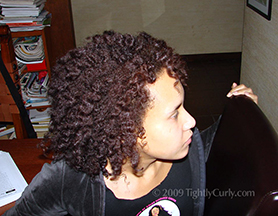
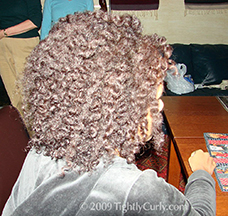
(Brianna's hair looks really red in these pictures, but that was because they were taken with a flash at close range, with no other light. It was funny, but as soon as I'd taken out her last twist, the power in the neighborhood went out, and we were in total darkness. Bob, who was so kind to take these photos, snapped a few shots in the pitch dark of Brianna. I couldn't see what her hair looked like (until viewing these photos later), so these were taken with no styling at all other than putting in the twists.)
|

|
The Mat
The Mat came as a big surprise to me, so I want to make sure you are warned about it. Though my hair didn't even reach shoulder-length at the time, it still took me over three hours to comb it and set it every week. The reason it took me three hours to comb and set my hair was that at the place where my new growth and chemical hair met would mat up really tight. When I first started, the mat was right up against my head and it really hurt to comb. It was as tight as thick batting especially at the top, back of my head, where my curls were tightest. But as my new hair grew out, the mats moved down. Finally, I couldn't stand it any more and cut off the chemicals. But by then I got to see what my real hair looked like for the first time in my life (after not knowing for 25 years!), and I loved it! Also, once the chemical hair was gone, my hair was so much easier to take care of. It stopped matting once the chemical hair was gone.
Good Conditioners for Tackling The Mat:
(for more information, you can find these conditioners on the
Combing Conditioner page):
*
Paula's ChoiceSmooth Finish Condtioner
*
Herbal EssencesDangerously Straight--ignore that it says straight, it just means it has more smoothing ingredients.
These are the smoothest combing conditioners I've tried so far.
Tips for Twists
It's best to do your twists early in the morning (like on a weekend when there may be more time) to give them time to dry all day. It's best to sleep in them. They can still be a little tiny bit damp when you sleep on them, but it's best to make sure they are totally dry before you take them out, or else they will frizz really badly, or not set firmly to last all week. Sleeping on the twists gives them time to set. Then, in the morning, you can take them out. It's best not to fingercomb them because that can make them fuzzy, as well as weaken the set.
Twists will give you spirals in your hair. The smaller each twist, the tighter the spiral. When you are setting your hair and it won't hold the twist because all the curl has been taken out, you can put clips on the ends of your hair while it dries. Keep them on until time to sleep, then remove them only long enough to bun or braid your twists to keep them in place at night.
Another thing you can try is doing this same thing, but with several braids, or even two french braids on either side of your head. For braids, you probably need to make sure your hair is dry first (because air can't get into braids to dry your hair very easily). Then spritz your hair lightly with a tiny amount of water to help it set, and braid your hair. Sleep in them. In the morning you should have lots of waves. Again, it's best not to comb them or get them wet because it may ruin your set, or it won't last all week.
For more pictures of what my relaxed hair looked like, as well as more on my growing-out-my-chemicals story, you can check out
Growing Out the Chemicals.
For what to do with your hair after the Big Chop, you can check out the tips in the
Curly Primer.
Know that when you grow out your joyful curls, you may be giving hope to someone wondering if they should go natural. The more people who are out there showing the world how beautiful natural curls are, the more we will educate people of all races that curls are wonderful and beautiful. And then there will be less girls who are forced as children to get their hair relaxed, or adults who think their curls are unacceptable so they straighten them and kill their sweet little curls.
|
|
|